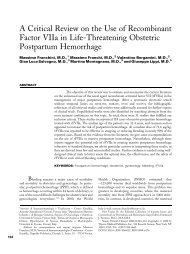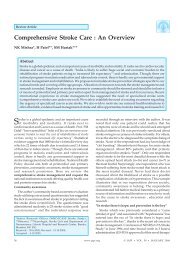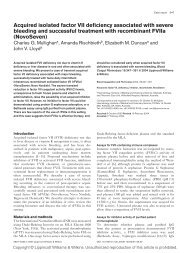Pathophysiology and management of dengue hemorrhagic fever
Pathophysiology and management of dengue hemorrhagic fever
Pathophysiology and management of dengue hemorrhagic fever
Create successful ePaper yourself
Turn your PDF publications into a flip-book with our unique Google optimized e-Paper software.
CHUANSUMRIT & TANGNARARATCHAKIT<br />
worthy that patients who are in threatened shock or<br />
shock stage, also known as <strong>dengue</strong> shock syndrome,<br />
usually remain conscious.<br />
The diagnosis <strong>of</strong> <strong>dengue</strong> infection is confirmed by<br />
testing positive for either virus isolation using culture<br />
or polymerase chain reaction from the clinical specimens<br />
such as serum in the early febrile stage, or serological<br />
studies. The positive serological studies define as<br />
a fourfold or more increase in the hemagglutination<br />
inhibition test between acute <strong>and</strong> convalescent sera or<br />
positive test for <strong>dengue</strong>-specific IgM/IgG performed by<br />
enzyme-linked immunosorbent assay (ELISA). The secondary<br />
<strong>dengue</strong> infection is defined when the hemagglutination<br />
inhibition titer was 1:2560 or more, or the ratio<br />
<strong>of</strong> IgG <strong>and</strong> IgM was > 1.8.<br />
PATHOGENESIS<br />
The pathogenesis <strong>of</strong> DHF is poorly understood. DHF<br />
caused by primary or secondary <strong>dengue</strong> infection is due<br />
to the occurrence <strong>of</strong> abnormal immune response involving<br />
production <strong>of</strong> cytokines or chemokines, activation<br />
<strong>of</strong> T-lymphocytes <strong>and</strong> disturbance <strong>of</strong> the hemostatic<br />
system. The elevated mediators include C3a, C5a, tumor<br />
necrosis factorα, interleukin (IL)-2, IL-6, IL-10,<br />
9–14<br />
interferonα <strong>and</strong> histamine. Halstead described the<br />
antibody-dependent enhancement whereby, upon the<br />
15<br />
second infection with a heterotypic <strong>dengue</strong> virus,<br />
the subneutralizing concentration <strong>of</strong> the cross-reacting<br />
antibody from the previous infection may opsonize the<br />
virus <strong>and</strong> enhance its uptake <strong>and</strong> replication in the<br />
macrophage or mononuclear cells. Secondary infection<br />
with a heterotypic <strong>dengue</strong> virus is associated with<br />
increased risk <strong>of</strong> developing DHF in individuals who<br />
have recovered from a primary <strong>dengue</strong> virus with a first<br />
serotype. The level <strong>of</strong> T-cell activation in a secondary<br />
<strong>dengue</strong> infection is also enhanced, occurring as a phe-<br />
16,17<br />
nomenon known as original antigenic sin, <strong>and</strong> is<br />
undergoing programmed cell death. Many <strong>dengue</strong>specific<br />
T-cells are <strong>of</strong> low affinity for the infected virus<br />
<strong>and</strong> show higher affinity for other, probably previously<br />
encountered serotypes. Pr<strong>of</strong>ound T-cell activation <strong>and</strong><br />
death during acute <strong>dengue</strong> infection may suppress or<br />
delay viral elimination, leading to the higher viral loads<br />
<strong>and</strong> increased immunopathology found in patients with<br />
16<br />
DHF.<br />
Interstitial dendritic cells located in the epithelia are<br />
believed to constitute the first line <strong>of</strong> the innate host<br />
© 2006 The Authors<br />
Journal Compilation © 2006 LMS Group • Transfusion Alternatives in Transfusion Medicine 8 (Suppl. 1), 3–11<br />
| MANAGEMENT OF DENGUE HEMORRHAGIC FEVER<br />
against invading <strong>of</strong> <strong>dengue</strong> virus after the initial bite<br />
by an infected mosquito. Infected dendritic cells migrate<br />
to regional lymph node along with their maturation<br />
process. Early activation <strong>of</strong> NK cell <strong>and</strong> type I interferon-dependent<br />
immunity may be important in limiting<br />
viral replication at the early time <strong>of</strong> <strong>dengue</strong><br />
18<br />
infection. Dendritic cell-specific ICAM-3 grabbing<br />
non-integrin (DC-SIGN) is a C-type lection that is<br />
expressed on certain dendritic cells to facilitate their<br />
dissemination in vivo.<br />
The genetic variation in DC-SIGN<br />
may have impact on the outcome after <strong>dengue</strong> virus<br />
exposure. Recently, an A-to-G transition located at<br />
nucleotide −336<br />
in the promoter region <strong>of</strong> DC-SIGN was<br />
found to be associated with an outcome <strong>of</strong> <strong>dengue</strong><br />
19,20<br />
infection. The A-to-G transition alters a sequence for<br />
an Sp1 binding site <strong>and</strong> diminishes promoter activity.<br />
In a case–control study in Thail<strong>and</strong>, it was found that<br />
−336<br />
A/G polymorphism in DG-SIGN was associated<br />
19<br />
with a reduced risk <strong>of</strong> severe <strong>dengue</strong> <strong>fever</strong>.<br />
PATHOPHYSIOLOGY<br />
Evidence <strong>of</strong> plasma leakage<br />
The plasma leakage is due to the increased vascular<br />
21<br />
permeability induced by several mediators such as<br />
C3a, C5a during the acute febrile stage <strong>and</strong> prominent<br />
during the toxic stage. The evidence <strong>of</strong> plasma leakage<br />
includes hemoconcentration, hypoproteinemia/hypoalbuminemia,<br />
pleural effusion, ascites, threatened shock<br />
<strong>and</strong> pr<strong>of</strong>ound shock. The rising hematocrit may not be<br />
evidenced because <strong>of</strong> either severe bleeding or early<br />
intravenous fluid replacement.<br />
Bleeding tendency<br />
The bleeding diathesis is caused by vasculopathy, thrombocytopenia,<br />
platelet dysfunction <strong>and</strong> coagulopathy.<br />
Vasculopathy<br />
A positive tourniquet test indicating the increased capillary<br />
fragility is found in the early febrile stage. It may<br />
be a direct effect <strong>of</strong> <strong>dengue</strong> virus as it appears in the<br />
15<br />
first few days <strong>of</strong> illness during the viremic phase.<br />
Thrombocytopenia <strong>and</strong> platelet dysfunction<br />
Patients with DHF usually have platelet counts less than<br />
9 100 × 10 /L as shown in Figure 1. Thrombocytopenia is<br />
5





